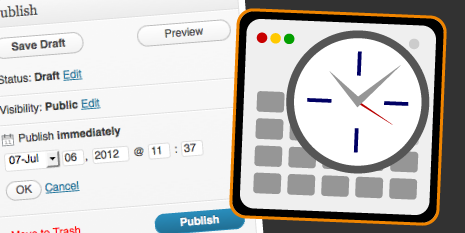
In mid June, I began to prepare to get out of the office for a few days. I had a vacation scheduled for the end of the month. I was looking forward to the break, and in particular, to the break from all the digital online activity. It was to be a break from the hustle and bustle of the online marketing world.
This preparation got me thinking about the value of scheduling the publication of content on this blog, on Twitter and elsewhere. As most readers know, on most content management systems for small businesses (like WordPress) and apps like Hootsuite, content can be scheduled for publication at a certain date and time. As part of a two post series, I will look at the pros and cons of such functionality, particularly as that functionality relates to inbound marketing for small businesses.
Pros of Scheduling Posting
1. Greater flexibility
As a blog reader, I appreciate when a writer established a publication schedule. Every Tuesday morning a new post is published. Or maybe it’s the third Wednesday of the month. Whatever. The point is that, as small business owners, we can’t always be in the office or online at our desired publication time. Scheduling posting can cover us when we have an important client meeting at our regular publication slot.
2. Increased efficiency
If we’re conducting an extended promotional campaign on Twitter, for example, it can be helpful to spend an hour or so at a single instance drafting, editing and scheduling a number of tweets which will be scheduled for publication throughout the week. We’re focused and attentive to the task and can make sure that
3. Avoiding distractions and hiccups
For small business owners, the “to do” list never really gets shorter. The “to do” items simply change names. A real value of scheduled publication functionality is that it can help ensure that we don’t forget or get too busy to carry on, for example, an inbound marketing campaign. We may want to run a series of blog posts connected by a topic stream. We might write a lengthy article on a particular topic and then divide that into a number of individual blog posts to be published over a few weeks. The publication scheduling feature ensures that those posts are published on time and in the intended order.
4. Covering more ground
This particular benefit is more for Twitter than for blogging. We may want to share links to important and relevant content on a daily basis. That can be difficult to manage on a day-to-day basis. Any small business owner will tell you that some days just get away. Scheduling a tweet a day, interspersed with our more organic tweets as and when we can, is an effective way to maintain a bigger social media presence.
5. Avoiding “Need something now”
We’ve all been there. A publication deadline looms before us. We feel its pressure and know that we have to get something online. Our mind wanders back to late last week when we had the hour of downtime. Why didn’t we write the post then and schedule it for publication today?
Of course, there are two sides to every coin. While there are clear advantages to scheduling posts and tweets in advance, there are also downsides. Stay tuned next week when I’ll publish a post covering 5 Cons of Scheduling Posted Content.
Pingback: 5 Cons of Scheduling Posted Content | Liam Dempsey